Assessing Potential Impacts of Sea Level Rise on Public Health and Vulnerable Populations in Southeast Florida and Providing a Framework to Improve Outcomes
Abstract
:1. Introduction
2. Materials and Methods
2.1. Sea Level and Groundwater Mapping
2.2. Southeast Florida Vulnerability Index
2.3. Statistical Analysis
3. Results
3.1. Sea-Level Rise Mapping
3.2. Results from the Statistical Analysis
3.3. Outreach
4. Discussion
4.1. Proposed Frameowrks
4.2. Needs
5. Conclusions
Acknowledgments
Author Contributions
Conflicts of Interest
References
- Heimlich, B.N.; Bloetscher, F.; Meeroff, D.E.; Murley, J. Southeast Florida’s Resilient Water Resources: Adaptation to Sea Level Rise and Other Impacts of Climate Change; Center for Urban and Environmental Solutions at Florida Atlantic University: Boca Raton, FL, USA, 2009; Available online: http:/www.ces.fau.edu/files/projects/climate_change/SE_Florida_Resilient_Water_Resources.pdf (accessed on 29 March 2016).
- Bloetscher, F.; Meeroff, D.E.; Heimlich, B.N. Improving the Resilience of a Municipal Water Utility against the Likely Impacts of Climate Change, A Case Study: City of Pompano Beach Water Utility; Florida Atlantic University: Boca Raton, FL, USA, 2009; Available online: http://www.ces.fau.edu/files/projects/climate_change/PompanoBeachWater_CaseStudy.pdf (accessed on 29 March 2016).
- Pachauri, R.; Reisinger, A. (Eds.) Contribution of Working Groups I, II and III to the Fourth Assessment Report to the Fourth Assessment Report of the Intergovernmental Panel on Climate Change; Climate Change 2007: Synthesis Report; IPCC: Geneva, Switzerland, 2007.
- Southeast Florida Regional Climate Change Compact Technical Ad hoc Work Group. A Unified Sea Level Rise Projection for Southeast Florida. A document prepared for the Southeast Florida Regional Climate Change Compact Steering Committee. 2011. Available online: http://southeastfloridaclimatecompact.org/pdf/Sea%20Level%20Rise.pdf (accessed on 15 December 2014).
- United States Census Bureau. State and County Quickfacts: Florida. 2012. Available online: http://quickfacts.census.gov/qfd/states/12000.html (accessed on 15 March 2015). [Google Scholar]
- Church, J.A.; White, N.J. Sea-level rise from the late 19th to the early 21st century. Surv. Geophys. 2011, 32, 585–602. [Google Scholar] [CrossRef]
- Gregory, J.M.; Browne, O.J.H.; Payne, A.J.; Ridley, J.K.; Rutt, I.C. Modelling large-scale ice-sheet-climate interactions following glacial inception. Clim. Past 2012, 8, 1565–1580. [Google Scholar] [CrossRef]
- Domingues, C.M.; Church, J.A.; White, N.J.; Gleckler, P.J.; Wijffels, S.E.; Barker, P.M.; Dunn, J.R. Improved estimates of upper-ocean warming and multi-decadal sea-level rise. Nature 2008, 453, 1090–1093. [Google Scholar] [CrossRef] [PubMed]
- Gregory, J.M. Sea level Rise: What Makes Prediction So Difficult? NERC: Atlanta, GA, USA, 2008; pp. 24–27. [Google Scholar]
- Vermeer, M.; Rahmstorf, S. Global sea level linked to global temperature. Proc. Natl. Acad. Sci. USA 2009, 106, 21527–21532. [Google Scholar] [CrossRef] [PubMed]
- Jevrejeva, S.; Moore, J.C.; Grinsted, A. How will sea level respond to changes in natural and anthropogenic forcings by 2100? Geophys. Res. Lett. 2010, 37, 256–265. [Google Scholar] [CrossRef]
- U.S. Army Corps of Engineers (USACE). Water Resource Policies and Authorities, Incorporating Sea level Change Considerations in Civil Works Programs; Expires July 2011; CECW-CE Circular No. 1165-2-211; Department of the Army, U.S. Army Corps of Engineers: Washington, DC, USA, 2009.
- Bloetscher, F.; Romah, T.; Berry, L.; Hernandez Hammer, N.; Cahill, M.A. Identification of Physical Transportation Infrastructure Vulnerable to Sea Level Rise. J. Sustain. Dev. 2012, 5, 40–51. [Google Scholar] [CrossRef]
- Bloetscher, F.; Romah, T. Tools for assessing sea level rise vulnerability. J. Water Clim. Chang. 2015, 6, 181–190. [Google Scholar] [CrossRef]
- Romah, T. Advanced Methods in Sea Level Rise Vulnerability Assessment. Master’s Thesis, Florida Atlantic University, Boca Raton, FL, USA, December 2012. [Google Scholar]
- Chang, S.W.; Clement, T.P.; Simpson, M.J.; Lee, K.K. Does sea-level rise have an impact on saltwater intrusion? Adv. Water Resour. 2011, 34, 1283–1291. [Google Scholar] [CrossRef]
- Bolter, K.P. Perceived Risk versus Actual Risk to Sea-Level Rise: A Case Study in Broward County; Florida Atlantic University: Boca Raton, FL, USA, 2014. [Google Scholar]
- Zhang, K. Analysis of non-linear inundation from sea-level rise using LIDAR data: A case study for South Florida. Clim. Chang. 2011, 106, 537–565. [Google Scholar] [CrossRef]
- Karl, T.; Melillo, J.; Peterson, T. (Eds.) Global Climate Change Impacts in the United State; Cambridge University Press: Cambridge, UK, 2009.
- Hanson, S.; Nicholls, R.; Ranger, N.; Hallegatte, S.; Corfee-Morlot, J.; Herweijer, C.; Chateau, J. A global ranking of port cities with high exposure to climate extremes. Clim. Chang. 2011, 104, 89–111. [Google Scholar] [CrossRef]
- Parkinson, R.W. Adapting to Rising Sea Level: A Florida Perspective. In Sustainability 2009: The Next Horizon; In Proceedings of the AIP Conference, Melbourne, FL, USA, 3–4 March 2009; Available online: https://411.fit.edu/sustainability/documents/FINAL%20-%20With%20Cover%2010-1-09.pdf (accessed on 28 March 2016).
- Southeast Florida Regional Climate Compact (SFRCCC). Analysis of the Vulnerability of Southeast Florida to Sea-Level Rise. 2012. Available online: http://www.southeastfloridaclimatecompact.org/wp-content/uploads/2014/09/regional-climate-action-plan-final-ada-compliant.pdf (accessed on 29 March 2016).
- Tebaldi, C.; Strauss, B.H.; Zervas, C.E. Modelling sea level rise impacts on storm surges along US coasts. Environ. Res. Lett. 2012, 7. Article 1. [Google Scholar] [CrossRef]
- Titus, J.G.; Richman, C. Maps of lands vulnerable to sea level rise: Modeled elevations along the US Atlantic and Gulf coasts. Clim. Res. 2001, 18, 205–228. [Google Scholar] [CrossRef]
- Weiss, J.L.; Overpeck, J.T.; Strauss, B. Implications of recent sea level rise science for low-elevation areas in coastal cities of the conterminous USA. Clim. Chang. 2011, 105, 635–645. [Google Scholar] [CrossRef]
- Haines, A.; Kovats, R.S.; Campbell-Lendrum, D.; Corvalan, C. Climate change and human health: Impacts, vulnerability and public health. Public Health 2006, 120, 585–596. [Google Scholar] [CrossRef] [PubMed]
- Hess, J.J.; McDowell, J.Z.; Luber, G. Integrating climate change adaptation into public health practice: Using adaptive management to increase adaptive capacity and build resilience. Environ. Health Perspect. 2012, 120, 171–179. [Google Scholar] [CrossRef] [PubMed]
- Kjellstrom, T.; McMichael, A. Climate change threats to population health and well-being: The imperative of protective solutions that will last. Glob. Health Act. 2013, 6. [Google Scholar] [CrossRef] [PubMed]
- Portier, C.; Thigpen Tart, K.; Carter, S.; Dilworth, C.; Grambsch, A.; Gohlke, J.; Hess, J.; Howard, S.; Luber, G.; Lutz, J.; et al. A Human Health Perspective on Climate Change: A Report Outlining the Research Needs on the Human Health Effects of Climate Change; Environmental Health Perspectives/National Institute of Environmental Health Sciences: Research Triangle Park, NC, USA, 2010. Available online: www.niehs.nih.gov/climatereport (accessed on 23 October 2014). [CrossRef]
- Doherty, T.J.; Clayton, S. The psychological impacts of global climate change. Am. Psychol. 2011, 66, 265–276. [Google Scholar] [CrossRef] [PubMed]
- Rose, J.B.; Epstein, P.R.; Lipp, E.K.; Sherman, B.H.; Bernard, S.M.; Patz, J.A. Climate variability and change in the United States: Potential impacts on water-and foodborne diseases caused by microbiologic agents. Environ. Health Perspect. 2001, 109 (Suppl. S2), 211–221. [Google Scholar] [CrossRef] [PubMed]
- Pleitez Herrera, F.J. Predicting Removal Efficiency of Reverse Osmosis Membranes with Respect to Emerging Substances of Concern Using a Discriminant Function Analysis. Master’s Thesis, Florida Atlantic University, Boca Raton, FL, USA, 2012. [Google Scholar]
- Esty, D.C.; Levy, M.; Srebotnjak, T.; de Sherbinin, A. Environmental Sustainability Index: Benchmarking National Environmental Stewardship; Yale Center for Environmental Law & Policy: New Haven, CT, USA, 2005. [Google Scholar]
- Funari, E.; Manganelli, M.; Sinisi, L. Impact of climate change on waterborne diseases. Ann. Ist. Super. Sanità 2012, 48, 473–487. [Google Scholar] [CrossRef] [PubMed]
- Southeast Florida Regional Climate Change Compact (SEFRCCC); Health Impact Assessment (HIA). Minimizing the Health Effects of Climate Change in the South Florida Region, Regional Climate Action Plan. Final Report. Available online: http://www.pewtrusts.org/~/media/assets/external-sites/health-impact-project/climatechangeinsouthfloridafinalreport31814.pdf?la=en (accessed on 28 March 2016).
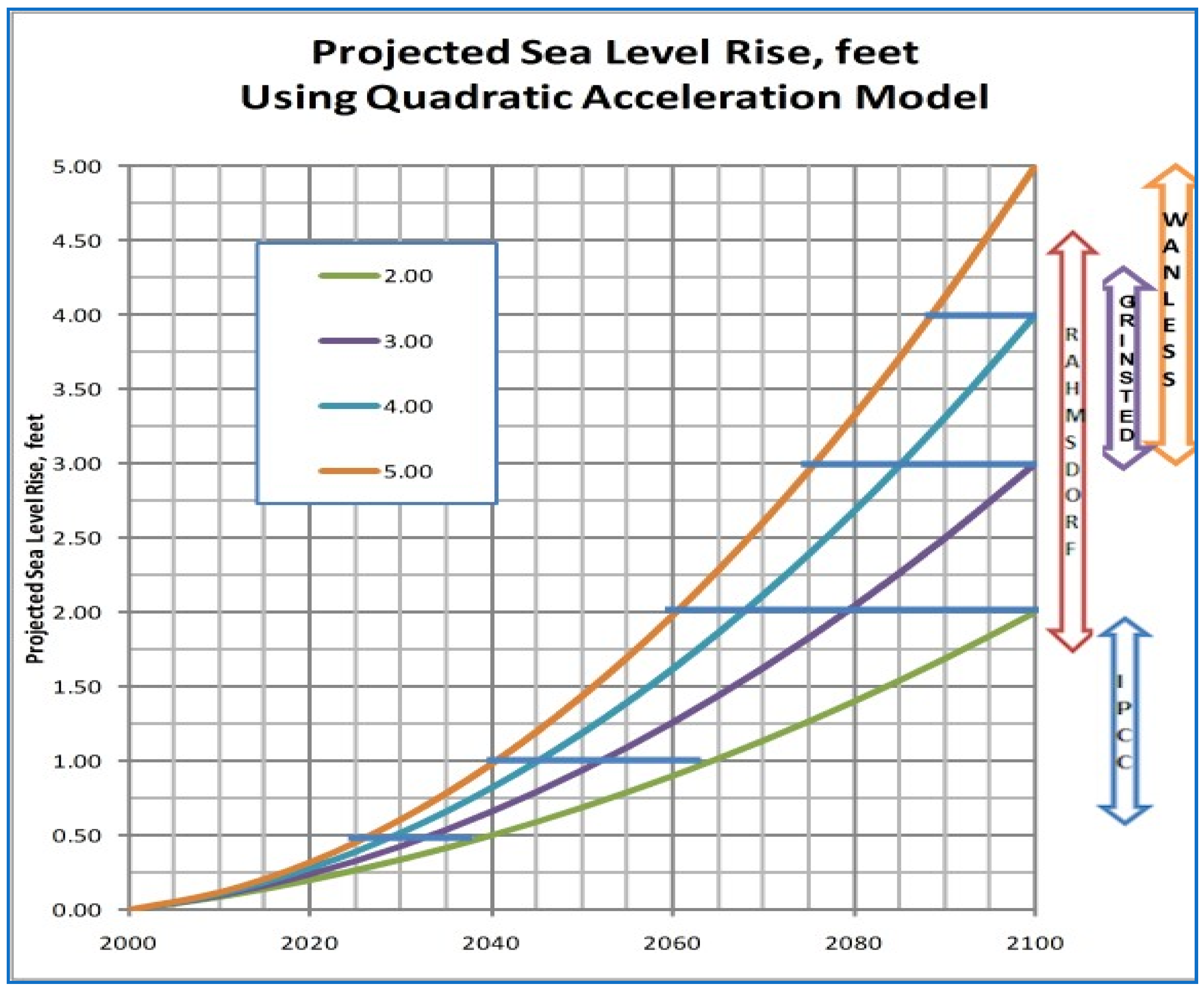
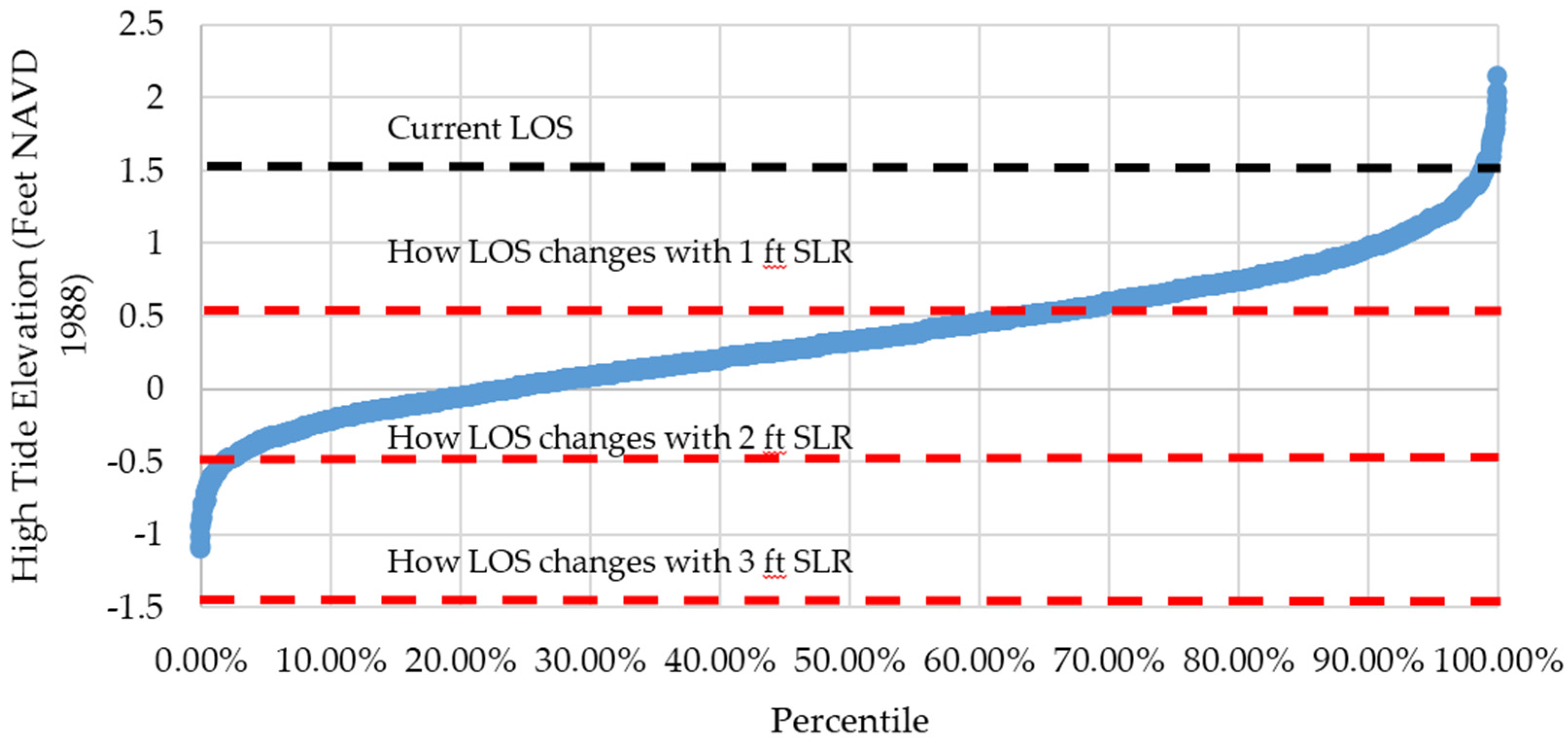
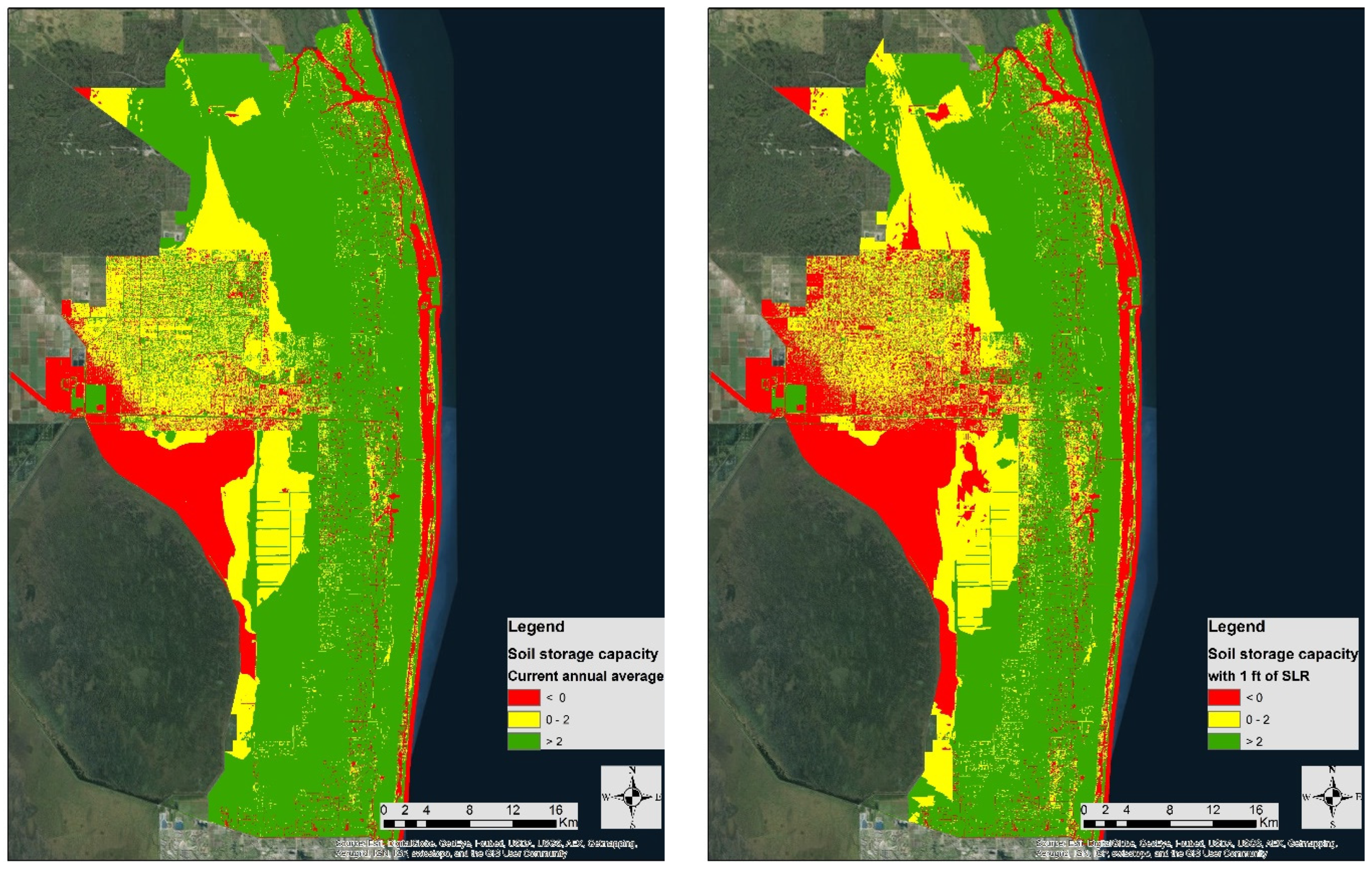
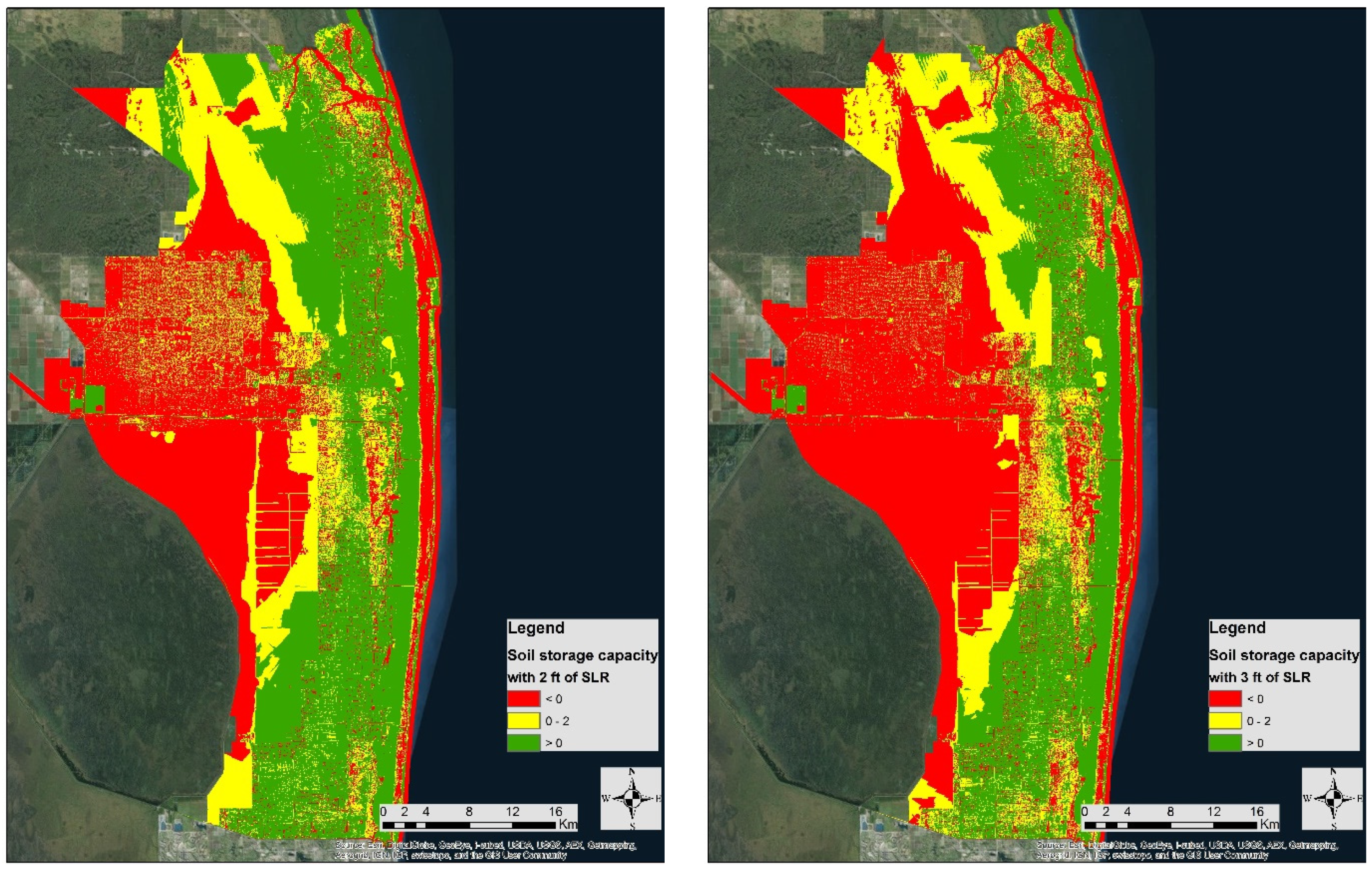
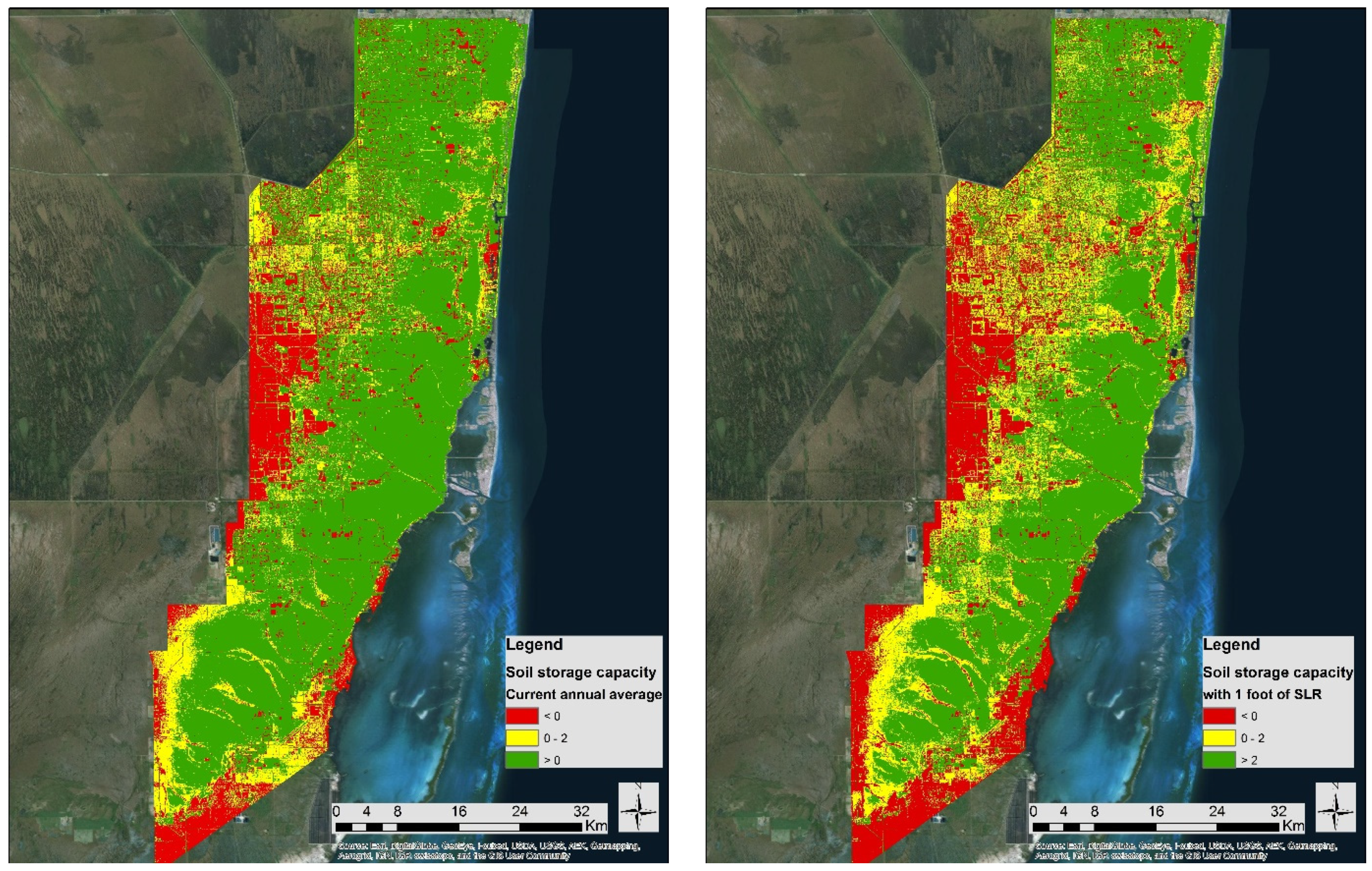
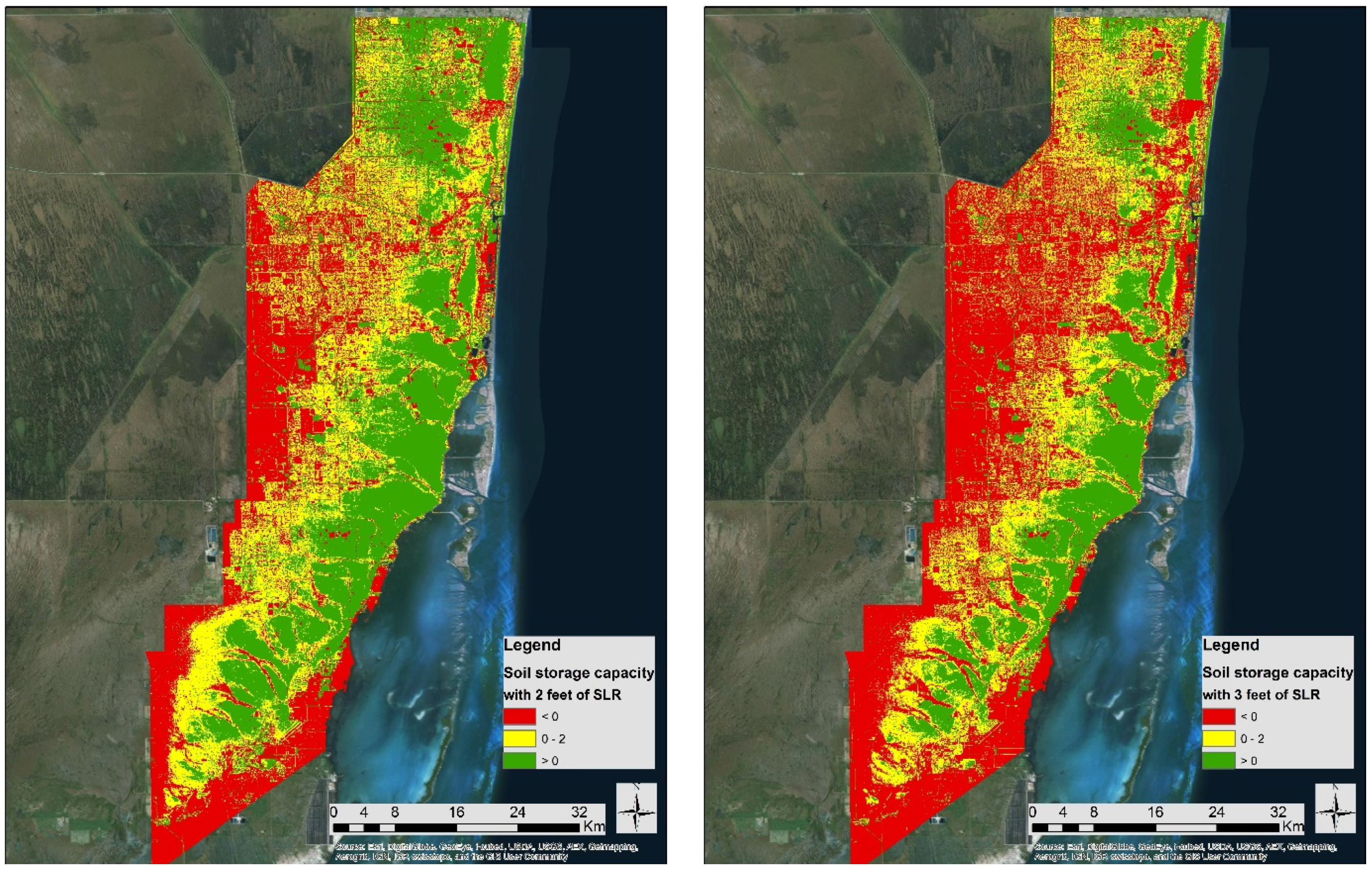
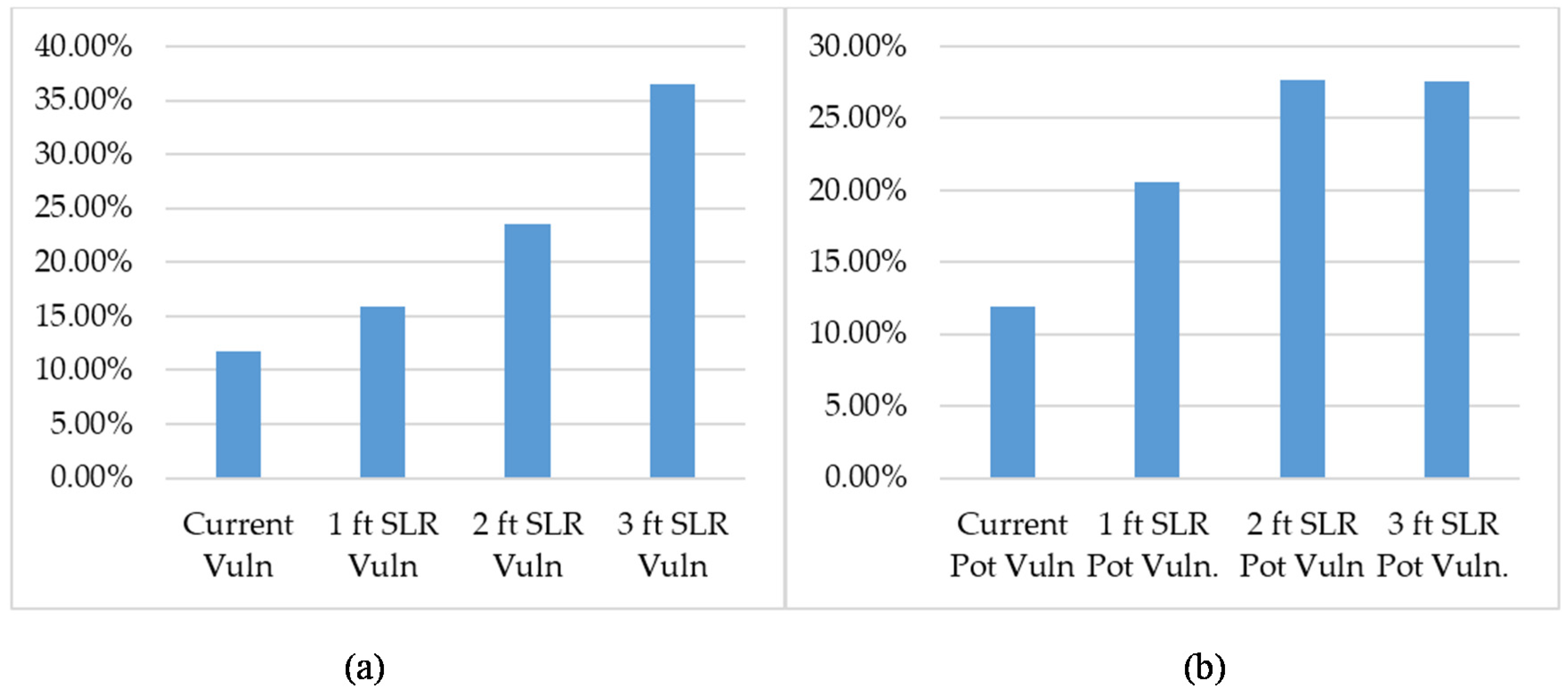
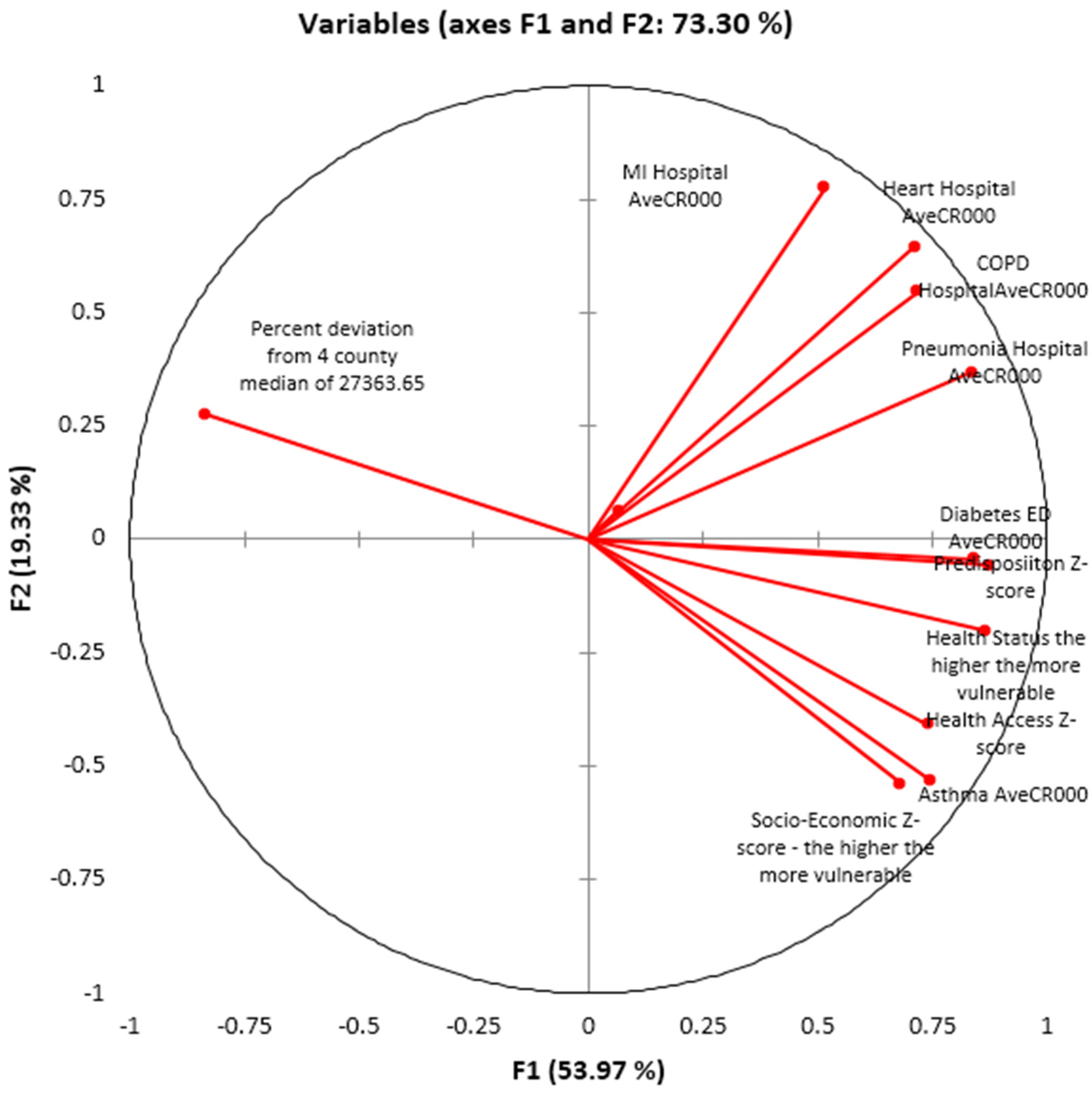
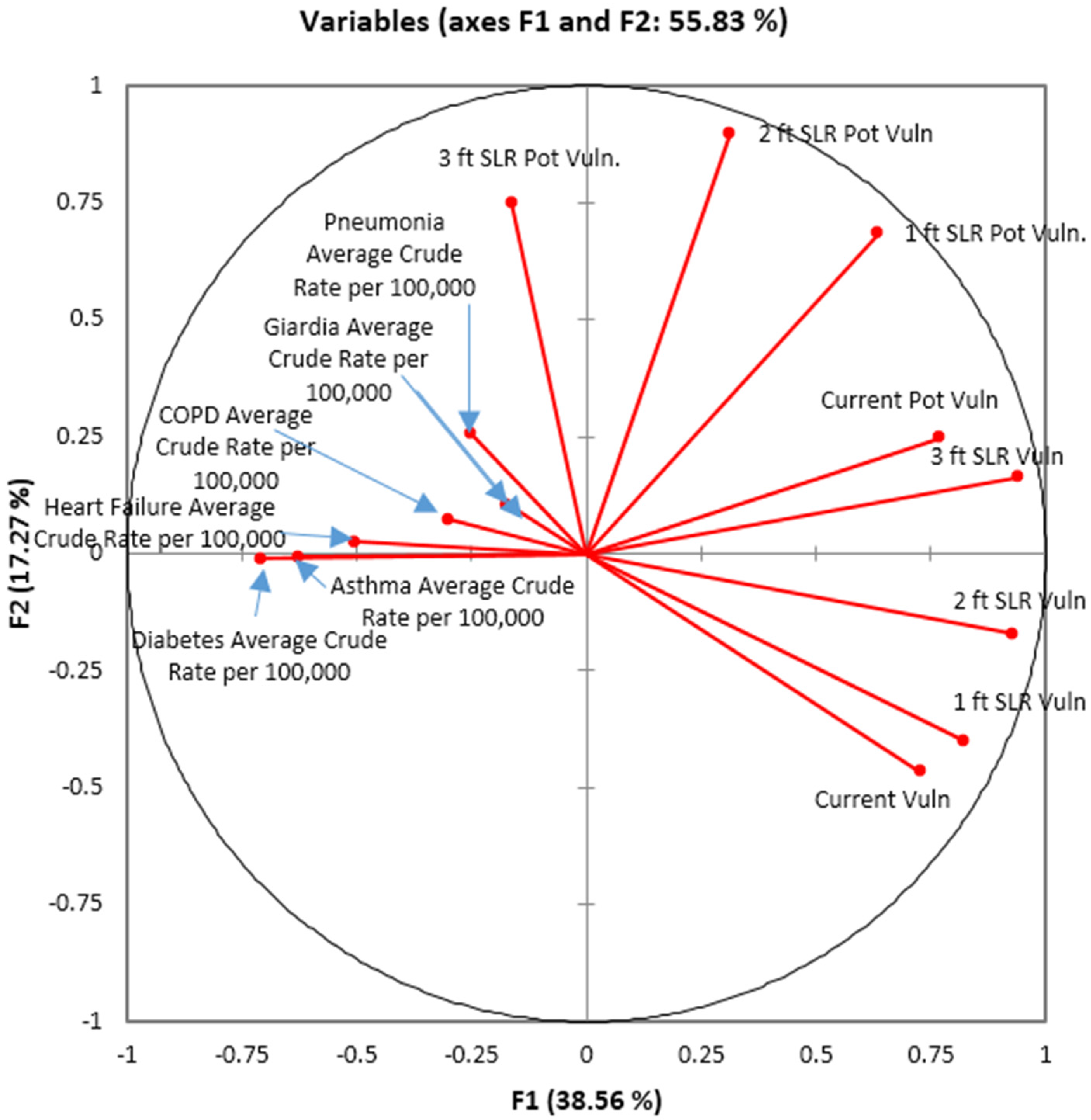
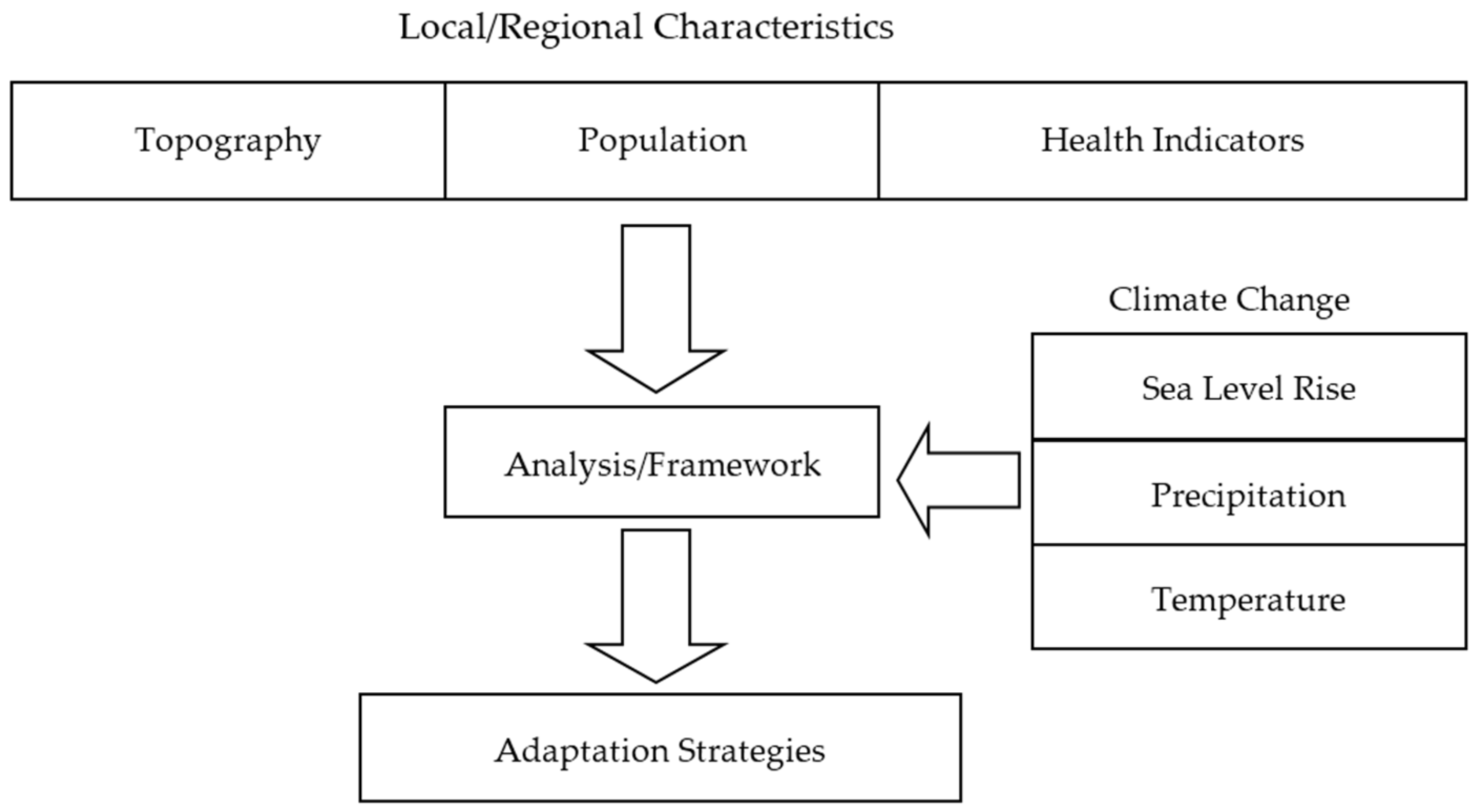
| Implementation Strategy | Benefits | Cost | Barriers to Implementation | Point When Action May Need to be Abandoned |
|---|---|---|---|---|
| Exfiltration Trenches | Excess water drains to aquifer, some treatment provided | $250/ft | Significant damage to roadways for installation, maintenance needed, clogging issues reduce benefits | If groundwater table is above exfiltration piping, the exfiltatrion efficiency diminishes quickly |
| Infiltration Trenches | Excess water gathered from soil and drained to pump stations, creating storage capacity of soil to store runoff, soil treatment | $250/ft plus pump station | Significant damage to roadways for installation, maintenance needed, clogging issues, costs for pump station | Complete inundation means pumps run constantly and pump the same water over and over |
| Install stormwater pumping stations in low lying areas to reduce storm water flooding (requires studies to identify appropriate areas, sites and priority levels) | Removes water from streets, reduces flooding | Start at $1.5 to 5 million each, number unclear without more study | NPDES permits, maintenance cost, land acquisition, discharge quality | When full area served is inundated (>3–5 ft SLR) |
| Added dry retention | Removes water from streets, reduces flooding | $200,000/acre | Land availability, maintenance of pond, discharge location | When full area served is inundated |
| Armoring the sewer system (G7 program) | Keeps stormwater out of sanitary sewer system and reduces potential for disease spread from sewage overflows. Major public health solution | $500/manhole | limited expense beyond capital cost | none |
| Central sewer installation in OSTDS areas | Public health benefit of reducing discharges to lawns, canals and groundwater from septic tanks | $15,000 per household | Cost, assessments against property owners | none |
| Raise roadways | Keeps traffic above floodwaters | $2–4 million/lane mile | Runoff, cost, utility relocation | When full area served is inundated |
| Class V gravity wells | Means to drain neighborhoods | $250,000 ea | Needs baffle box, limited flow volume (1 MGD) | When full area served is inundated |
| Class I injection wells | Means to drain neighborhoods, 15 MGD capacity | $6 million | Needs baffle box | When full area served is inundated |
| Bioswales | Means to drain neighborhoods, provides treatment of water | $0.5 million/mile | land area, flow volume, maintenance | When full area served is inundated |
| Raise sea walls | Protects property | $0.1–1 million/property | Private property rights, neighbors | n/a |
| Relocate wellfields westward/horizontal wells | $20 million assuming locations can be permitted in Biscayne aquifer | $20 million assuming locations can be permitted in Biscayne aquifer | Cost, concern over saltwater intrusion east and west, inundation of wellfields, permitting by SFWMD | When well is inundated |
| Salinity/lock structures | Keeps sea out, reduces saltwater intrusion | Up to $10 million, may require ancillary storm water pumping stations at $2–5 million each | SFWMD, western residents, private property rights arguments | n/a—solution to retard sea encroachment and saltwater intrusion |
| Regional relocation of locks and/or conversion to pump stations | Creates regional system to use coastal ridge to protect inland property, keeps saltwater out | $200 million each | SFWMD, western residents, private property rights arguments | n/a—solution to retard sea encroachment and protect property which can exist at levels below sea level |
| Pump to Tide | huge volume of water can be removed from urban area | unknown | Water quality to reefs, sea grasses, etc. | When full area served is inundated |
| Water Resource Adaptation Alternatives |
|---|
| Water conservation Reducing requirements for additional treatment capacity and development of alternative water supplies (AWS) |
| Reducing the impact of sea-level rise on existing water sources Hydrodynamic barriers: aquifer injection/infiltration trenches to counteract saltwater intrusion using treated wastewater Horizontal wells Salinity structures and locks control advance of saltwater intrusion Relocation of wellfields when saltwater intrusion or other threats render wellfield operations impractical |
| Gaining access to alternative water resources Desalination of brackish waters Regional alternative water supplies Capture and storage of stormwater in reservoirs and impoundments Aquifer storage and recovery (ASR) |
| Wastewater reclaim and reuse Irrigation to conserve water and recharge aquifer Industrial use and for cooling water Indirect aquifer recharge for potable water |
| Stormwater management Reengineering canal systems, control structures and pumping |
| Implementation Strategy | Benefits | Cost | Barriers to Implementation | Point When Action May Need to be Abandoned |
|---|---|---|---|---|
| Increase Access to Health Care | Improved health care access should reduce impacts, e.g., vaccinations will not be possible for all climate-related conditions, because of the state of the art in vaccines | unknown | Cost, ongoing operations | Would occur only if the entire region was abandoned. |
| Reduce potential for forced migration | Lessens risk of socially-vulnerable people moving out vulnerable areas | unknown | Pressure from developers, rental properties at risk | n/a |
| Redevelopment control ordinances and policies | reduces competition for land by removing land from redevelopment | unknown | Pressure from developers, rental properties at risk, property rights issues | Would occur only if the entire region was abandoned |
| Assessments for hard infrastructure | provides funding to support social efforts | see Table 1 and Table 2 | Public resistance or public support | Would occur only if the entire region was abandoned |
| Public acquisition of at risk property | reduces potential for migration to vulnerable property by taking property out of circulation | various land regulatory tools: land lease, outright purchase, condemnation; may provide short-term income | Public resistance or public support | n/a |
| Vaccinations | reduces risk | n/a | Public resistance or public support | n/a |
| Risk Communication | improves communication to residents about their vulnerability | unknown | Public awareness | n/a |
| Outreach | improves communication to residents about vulnerability | unknown | Public awareness | n/a |
© 2016 by the authors; licensee MDPI, Basel, Switzerland. This article is an open access article distributed under the terms and conditions of the Creative Commons by Attribution (CC-BY) license (http://creativecommons.org/licenses/by/4.0/).
Share and Cite
Bloetscher, F.; Polsky, C.; Bolter, K.; Mitsova, D.; Garces, K.P.; King, R.; Carballo, I.C.; Hamilton, K. Assessing Potential Impacts of Sea Level Rise on Public Health and Vulnerable Populations in Southeast Florida and Providing a Framework to Improve Outcomes. Sustainability 2016, 8, 315. https://doi.org/10.3390/su8040315
Bloetscher F, Polsky C, Bolter K, Mitsova D, Garces KP, King R, Carballo IC, Hamilton K. Assessing Potential Impacts of Sea Level Rise on Public Health and Vulnerable Populations in Southeast Florida and Providing a Framework to Improve Outcomes. Sustainability. 2016; 8(4):315. https://doi.org/10.3390/su8040315
Chicago/Turabian StyleBloetscher, Frederick, Colin Polsky, Keren Bolter, Diana Mitsova, Kristin Palbicke Garces, Roderick King, Isabel Cosio Carballo, and Karen Hamilton. 2016. "Assessing Potential Impacts of Sea Level Rise on Public Health and Vulnerable Populations in Southeast Florida and Providing a Framework to Improve Outcomes" Sustainability 8, no. 4: 315. https://doi.org/10.3390/su8040315
APA StyleBloetscher, F., Polsky, C., Bolter, K., Mitsova, D., Garces, K. P., King, R., Carballo, I. C., & Hamilton, K. (2016). Assessing Potential Impacts of Sea Level Rise on Public Health and Vulnerable Populations in Southeast Florida and Providing a Framework to Improve Outcomes. Sustainability, 8(4), 315. https://doi.org/10.3390/su8040315






